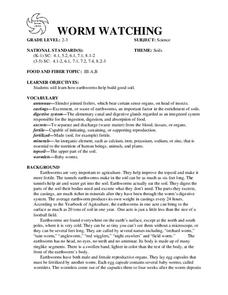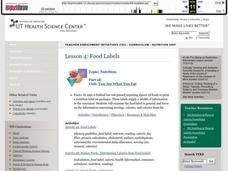Curated OER
Trophic Ecology of Humans
Students analyze the trophic level of humans by first calculating the kilocalories in own their lunch. They then calulate the kilocalories in a wide variety of foods found in grocery stores and compare the kilocalories needed to acquire...
Curated OER
WORM WATCHING
Students investigate how earthworms help build good soil. They examine the worms carefully to find the ringlike segments and swollen band at the front of the earthworm's body. Students take turns dampening the soil every day and adding...
Curated OER
Horticulture and Gardening
This 6 page information packet provides an overview of gardening and plants. Using this activity, students could design their own gardens, using math, science and writing skills. There are 30 questions involved.
Curated OER
From Foraging to Farming
Students experience the difficulty that goes along with foraging for food. In this activity on the importance of modern agriculture, students simulate how there simply is not enough food and water for everyone when agricultural means are...
Curated OER
Frozen, Canned or Fresh?
Students compare spinach. In this Science lesson, students construct an experiment to test fresh, frozen, and canned spinach taste and texture. Students record their findings in charts and graphs.
Curated OER
Finding Your Way On the Farm
Third graders explore the food industry by viewing a presentation about farming. In this farming geography lesson, 3rd graders view globes and maps while identifying the prime geographical locations for fertile land. Students view a...
Curated OER
Farm to Lunch: Exploring Agricultural Careers
Fourth graders examine Utah's economic structure and learn about agricultural careers. In this agricultural careers lesson, 4th graders follow agricultural products from their source to the lunch table. Students chart their results to...
Curated OER
Biomolecules
Students perform an experiment in which they test foods for the presence of proteins, carbohydrates, and lipids. They identify the molecular structure of each type of biomolecule and then discuss how biomolecules relate to nutrition and...
Curated OER
Dietary Guidelines for Good Nutrition
Students examine Dietary Guidelines for Americans developed by United States Department of Agriculture, analyze their diets for three days, and determine if their diets met the recommended dietary allowances (RDA) for their age and sex.
Curated OER
Introduction to Nutrition and Gardening
Young scholars examine the different parts of a plant and each ones role. In this exploratory activity students complete several activities including a game of charades.
Curated OER
Nutrition in Space
Learners compare and contrast the process of dehydration with the processes of freezing and canning. They predict energy sources that may be accessible in the future in different environments such as the moon and planets, most notably Mars.
Curated OER
Interdisciplinary Unit On Wellness
Students create a portfolio throughout their middle school years on wellness. Students explore their awareness of the connections between health, physical education, and family and consumer sciences with particular emphasis on the areas...
Curated OER
Lesson: Living With the Farm Next Door
Discuss with learners why farms are growing in size and why there is sometimes conflict between farmers and their non-farming neighbors. Read the article, "Living With the Farm Next Door," and then craft letters to the editor from the...
Curated OER
Yo! Gert-making yogurt
Young scientists or chefs culture yeast to produce yogurt. The materials and a general description of how make yogurt are provided, but there is very little detail otherwise. You could use this as an activity when your biology class is...
Curated OER
You Are What You Eat
Learners examine food labels and study serving size and calories. In this healthy eating lesson students complete several activities to understand food labels.
Curated OER
Student Worksheet Dietary Record
In this health worksheet students write down the number of calories consumed and the types of foods in an attempt to control health.
Curated OER
By Golly By Gum
Students identify the different steps in the scientific method. In this inquiry instructional activity, students determine the mass of the gum after chewing it for sometime. They explain what happens to the lost mass.
Curated OER
The Six Nutrients Student Worksheet
In this health worksheet, learners answer ten questions based around the concept of the different types of foods like carbohydrates, proteins, and fats with an emphasis upon how they are used in the body.
Curated OER
Symbiotic Relationships
Offering a comprehensive overview of symbiotic relationships, this presentation would be a great way to introduce or review material covered in a biology class. There are definitions, examples, and a quiz on the meaning of parasitism,...
Curated OER
They Don't Just Eat Grass
Middle schoolers consider the USDA daily recommendations to create a "feed" product for middle schoolers. For this Health lesson, students learn about the ingredients in feed that is fed to livestock and apply the method to creating feed...
Curated OER
An Inside Look at Apples
First graders examine and identify parts of an apple. In this biology lesson, 1st graders cut an apple in half and locate all the parts, use the apple halves as stamps, and create a bar graph displaying which apple types the students...
Curated OER
Daily Food Diary of an Elderly Person
In this health instructional activity, students keep a food diary for an elderly person that could be a friend or relative. Each entry needs to be recorded accurately.
Curated OER
Why Garden in New York State Schools?
A lovely presentation in which slide after slide outlines the many educational, physical, emotional, and social benefits of gardening in schools. This presentation is meant to be shown to parents, and would be a terrific choice to...
Curated OER
Agriculture: It Doesn't Just Happen
After reading an informational text on the Agricultural Research Service, learners research the role of the ARS in Oklahoma. Using reputable online sources, they label a map of the state with relevant areas. Researchers focus on one of...

























